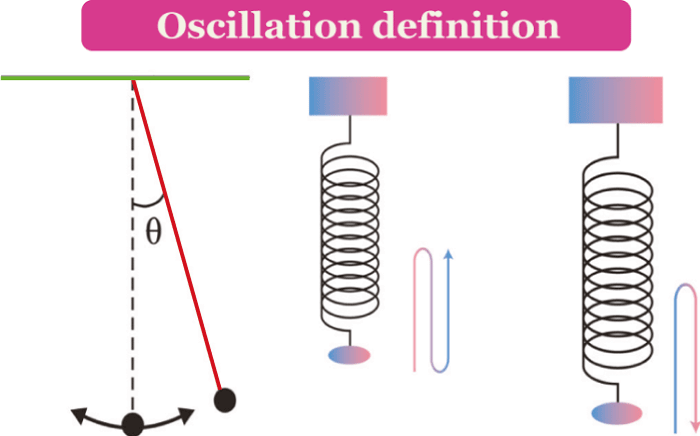Math Is Fun Forum
You are not logged in.
- Topics: Active | Unanswered
Pages: 1
#1 2024-01-19 15:18:00
- Jai Ganesh
- Administrator

- Registered: 2005-06-28
- Posts: 52,658
Oscillation
Oscillation
Gist
Oscillation is when something "vibrates", or repeats the same pattern. Many things in nature move back-and-forth or up-and down when pushed or struck. In time, natural oscillators slow down and stop because of friction.
Examples
* The pendulum of a "grandfather clock", for example, is a very slow oscillator.
* The strings of pianos and string instruments "oscillate" when struck by a hammer.
* An ocean surface wave is the result of water moving up and down.
* Circuits powered by electricity can "oscillate". Such circuits can be used to make sounds or radio waves.
* Different chemicals, when you mix them together in the right order, can make some new things. But then these things change back to the original ones, making this repeating pattern. These are called chemical oscillators.
Details
The oscillation of an item is the recurrent switching back and forth between two locations. It is often called periodic motion since it appears to return to itself constantly. For instance, an up-and-down motion caused by a spring's weight or a sine wave caused by a pendulum swinging from side to side.
Oscillation is the repetitive or periodic variation, typically in time, of some measure about a central value (often a point of equilibrium) or between two or more different states. Familiar examples of oscillation include a swinging pendulum and alternating current. Oscillations can be used in physics to approximate complex interactions, such as those between atoms.
Oscillations occur not only in mechanical systems but also in dynamic systems in virtually every area of science: for example the beating of the human heart (for circulation), business cycles in economics, predator–prey population cycles in ecology, geothermal geysers in geology, vibration of strings in guitar and other string instruments, periodic firing of nerve cells in the brain, and the periodic swelling of Cepheid variable stars in astronomy. The term vibration is precisely used to describe a mechanical oscillation.
Oscillation, especially rapid oscillation, may be an undesirable phenomenon in process control and control theory (e.g. in sliding mode control), where the aim is convergence to stable state. In these cases it is called chattering or flapping, as in valve chatter, and route flapping.
Simple harmonic oscillation
The simplest mechanical oscillating system is a weight attached to a linear spring subject to only weight and tension. Such a system may be approximated on an air table or ice surface. The system is in an equilibrium state when the spring is static. If the system is displaced from the equilibrium, there is a net restoring force on the mass, tending to bring it back to equilibrium. However, in moving the mass back to the equilibrium position, it has acquired momentum which keeps it moving beyond that position, establishing a new restoring force in the opposite sense. If a constant force such as gravity is added to the system, the point of equilibrium is shifted. The time taken for an oscillation to occur is often referred to as the oscillatory period.
The systems where the restoring force on a body is directly proportional to its displacement, such as the dynamics of the spring-mass system, are described mathematically by the simple harmonic oscillator and the regular periodic motion is known as simple harmonic motion. In the spring-mass system, oscillations occur because, at the static equilibrium displacement, the mass has kinetic energy which is converted into potential energy stored in the spring at the extremes of its path. The spring-mass system illustrates some common features of oscillation, namely the existence of an equilibrium and the presence of a restoring force which grows stronger the further the system deviates from equilibrium.
Damped oscillations
All real-world oscillator systems are thermodynamically irreversible. This means there are dissipative processes such as friction or electrical resistance which continually convert some of the energy stored in the oscillator into heat in the environment. This is called damping. Thus, oscillations tend to decay with time unless there is some net source of energy into the system. The simplest description of this decay process can be illustrated by oscillation decay of the harmonic oscillator.
Damped oscillators are created when a resistive force is introduced, which is dependent on the first derivative of the position, or in this case velocity. The differential equation created by Newton's second law adds in this resistive force with an arbitrary constant b. This example assumes a linear dependence on velocity.

It appears to me that if one wants to make progress in mathematics, one should study the masters and not the pupils. - Niels Henrik Abel.
Nothing is better than reading and gaining more and more knowledge - Stephen William Hawking.
Offline
Pages: 1